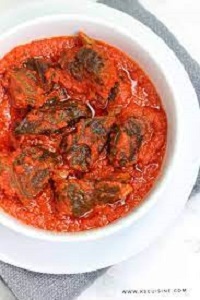Nigerian Beef Stew Recipe: How to Make African Beef Sauce
Nigerian Beef Stew Recipe: How to Make Best African Beef Sauce

The Nigerian Beef stew is a well-known and well-liked Nigerian dish that is similar to Ghanaian Beef Stew
It’s stuffed with beef, tripe, and liver. The entire stew is made in a single pot. Because this stew is made with tomatoes, it is also known as tomato stew.
Nigerian (African) beef stew is one of the many ethnic stew dishes that can be found in West African and even Caribbean cuisine.
This simple Nigerian red stew sauce is produced with simple components such as bell peppers, tomatoes, herbs, and aromatics, and, of course, boiled grilled or fried beef as the protein source.
If you see African tomato sauce or Nigerian tomato stew, you might think it’s just tomatoes in a stew.
But it isn’t. Some people make this recipe with only tomatoes, but I like a combination of tomatoes and bell peppers because it tastes much better than the former.
A stew made entirely with tomatoes may taste more sour and acidic than one made with tomatoes and bell peppers.
Table of Contents
Related on Nigerian Beef Stew
- Recipe for Nigerian Beef Stew
- Boiled Beef Recipe: How to Boil Meat Perfectly Each Time
- Red Red Ghanaian Bean Stew: Vegetarian, Vegan, Gluten-Free
- Feijoada Recipe: Brazilian Black Bean Stew
What Exactly Is Nigerian Stew?
Nigerian (Beef) Stew also known as West African Nigerian tomato stew is a tasty, thick, and somewhat spicy West African stew cooked with blended tomatoes, red bell peppers, habanero peppers, beef (or any other meat varieties), and spices to perfection.
It is extremely adaptable and goes well with a wide range of foods!
Nigerian stew is the country’s most popular cuisine, generally served with rice, boiled yam and even fufu!
It is unquestionably a home staple in every Nigerian household!
Is Nigerian (Beef) Stew Hot?
Nigerian (Beef) stew is frequently hot due to the use of scotch bonnet or habanero peppers.
These spicy peppers assist to reduce the acidity of the tomatoes while also improving the flavor of the stew. Depending on your taste, you can add more or less pepper.
Ingredients for Beef Stew in Nigeria
- 700g Diced Beef
- 3 Red Onions (diced)
- 5 Cloves Garlic (minced)
- 8 Tomatoes (halved and seeds removed)
- 1 Red Pepper (seeds removed)
- 1/3 Cup Oil
- Knob Fresh Ginger
- Pinch Grated Nutmeg
- 3-4 tbsp. Home-Made Stock & 2 Gluten-Free Stock Cubes
- 2 tbsp. Tomato Puree
- 5 tbsp. Gluten-Free All-Purpose Seasoning
- 1 Scotch Bonnet
- 2 tbsp. Cumin Seeds (optional)
- 2 tbsp. Dried Mixed Herbs
- 5 tbsp. Curry Powder
- 2 tbsp. Black Pepper
- 2 Bay Leaves
Preparation
- Place the meat in a small pot after rinsing it in cold water.
- Stir in half of the onions, garlic, ginger, all-purpose seasoning, curry, mixed herbs, cumin, and black pepper.
- Add enough boiling water to cover the beef, cover with a lid, and cook for a few minutes on medium heat before lowering and cooking for 20-30 minutes, or until the water increases from the meat and then reduces into a delicious, rich gravy.
- Ensure that you stir the beef every 10-15 minutes whilst cooking to ensure that nothing gets stuck to the bottom of the pot.
- Remove the meat from the gravy and drain any extra gravy from the meat after removing it from the cooker.
- Set aside both the gravy and the meat.
- Puree the tomatoes, onions, ginger, garlic, and scotch bonnet in a blender until smooth. (A little water can be added to help with the blending.)
- Heat the oil in a separate – larger – saucepan before adding the mixed ingredients.
- The pot should be heated enough for the additional ingredients to begin spitting.) If you’re spitting a lot, turn down the heat.
- Stir in the remaining half of the meat components, as well as the nutmeg, bay leaves, tomato puree, and stock cubes.
- Combine all of the ingredients in a mixing bowl and cover.
- Cook the stew on low to medium heat until it resembles (but is thicker than) bolognese sauce. This should take about 40 minutes to complete.
- Add the meat and reduced beef gravy and continue to simmer the stew until it’s a nice, rich thick consistency before removing from the heat and covering until ready to serve.
- Garnish with fried plantains and cauliflower rice.
- If using chicken instead of beef, separate from the reduced gravy and sauté for a few minutes on medium to high heat (to further seal in and increase the flavor) before adding to the stew.
Alternatively, you can cook the beef in the same manner before adding it to the stew, although this is not required.
- This nutritious stew can be stored in the refrigerator for several days.
- The tomato-to-onion ratio is normally 4:1, so keep this in mind if you want to change the amount next time you make this stew.
People also ask
What is the name of the beef used in the stew?
The front shoulder, often known as the chuck, produces the tastiest (and least expensive) beef stew meat.
The rear muscle (commonly known as the round) would be excellent in a stew, but we prefer chuck since it has more connective tissue.
What is the best beef to use in a stew?
There is no better cut of beef for beef stew than chuck! For the most tender flavor, get a thick chuck pot roast and chop it into chunks.
Chuck roast is a harder cut of meat than sirloin or rib roast, and it benefits greatly from pressure cooking or slow boiling to produce the greatest beef stew!
How do you cook beef in Nigeria?
We cook using cattle offal, often known as varied meat, in Nigerian recipes. Tripe, lung, and other parts of the beef take longer to cook.
I parboil offal for about 10 minutes with salt and onions, then rinse and clean it before seasoning it with less salt and simmering it on low heat until soft.
What can you substitute for stew meat?
To substitute the stew meat, use chicken, or pork roast portions such as shoulder roast, sirloin roast, blade roast, or baby back ribs.
Before serving the stew, remove the bones. If you substitute pork for beef, the resulting meal will not have a pronounced meaty flavor, but it will still have a rich flavor from the pork.
Is cooked beef good for you?
Cooking meat softens the rough fibers and connective tissue, making it easier to chew and digest.
It also improves nutrition absorption. Furthermore, correctly cooking meat removes dangerous bacteria such as Salmonella and E.


